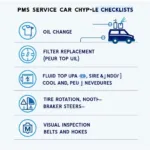Car Service Tags are essential for maintaining your vehicle and ensuring its longevity. They serve as reminders for necessary maintenance and repairs, contributing significantly to the overall safety and performance of your car. Understanding their importance and how to manage them effectively is crucial for every car owner. This guide will delve into the intricacies of car service tags, covering everything from their purpose to different types and best practices for managing them. Let’s get started.
What are Car Service Tags and Why are They Important?
Car service tags are small, often adhesive labels, attached to a vehicle after a service or repair. They typically display key information like the date of service, the mileage at the time of service, and the next recommended service date or mileage. These tags serve as a convenient visual reminder for car owners to schedule their next service appointment, ensuring that essential maintenance tasks are not overlooked. Ignoring recommended service intervals can lead to costly repairs down the line, decreased vehicle performance, and even safety hazards.
Having a well-maintained vehicle contributes to its resale value. A complete service history, as documented through car service tags and receipts, can assure potential buyers that the car has been properly cared for. This documented history can significantly increase the car’s appeal and potentially command a higher price. After your next visit to an independent car service, make sure you receive a car service tag.
Different Types of Car Service Tags
Car service tags come in various forms, each designed to convey specific information. Some common types include:
- Oil Change Tags: These tags typically indicate the date and mileage of the last oil change and recommend the next oil change interval.
- Inspection Tags: These tags are often used for state-mandated vehicle inspections and display the expiration date of the inspection.
- General Service Tags: These tags can be used for various services, such as tire rotations, brake inspections, and other routine maintenance procedures.
- Custom Service Tags: Some service centers utilize custom tags that can include specific recommendations based on the vehicle’s make, model, and service history.
Understanding the different types of car service tags will help you keep track of your vehicle’s maintenance schedule and ensure all necessary services are performed on time.
Best Practices for Managing Car Service Tags
Effectively managing your car service tags is key to maintaining a well-maintained vehicle. Here are some best practices to follow:
- Placement: Place the tag in a visible location, such as the upper left corner of the windshield, where it can serve as a constant reminder.
- Record Keeping: In addition to the tags, maintain a detailed service record book or digital log of all maintenance performed on your vehicle.
- Regular Checks: Regularly check your car service tags and schedule appointments accordingly. Don’t wait until the last minute.
- Don’t Remove Prematurely: Resist the urge to remove tags before the recommended service is due. They serve as a valuable reminder.
By adhering to these practices, you can ensure your vehicle receives the necessary care and attention it needs to perform optimally and safely.
What Happens if I Lose a Car Service Tag?
Losing a car service tag isn’t the end of the world. Contact the service center that issued the tag, and they should be able to provide you with a replacement or access your service records. You can also check your owner’s manual for recommended service intervals. Remember, maintaining accurate service records is essential for warranty claims and resale value.
How Can CarServiceRemote Help You with Car Service Tags?
CarServiceRemote offers valuable resources and information to help you understand and manage your car service tags. We provide articles, guides, and tips on various car maintenance topics. Our goal is to empower car owners with the knowledge they need to make informed decisions about their vehicle’s care. Check out our resources on urs car service centre and abt maruti car service in coimbatore for more specific information.
Conclusion
Car service tags are a crucial aspect of car maintenance, providing vital reminders for necessary services and contributing to the overall health and longevity of your vehicle. By understanding their importance and following the best practices outlined in this guide, you can keep your car running smoothly and safely for years to come. Remember to always check your car service tags and schedule your next service appointment promptly. Regular maintenance is the key to a reliable and safe vehicle. If you’re looking for resources on modern classified ad listings for car services, visit our page on modern classified ad listing car services html. Don’t forget to check out popular car service kollam for more information on service options in Kollam.
FAQ
- What information is typically on a car service tag?
- Where should I place my car service tag?
- What should I do if I lose my car service tag?
- How can I find a reliable car service center near me?
- What is the importance of regular car maintenance?
- How often should I get my oil changed?
- Are there different types of car service tags?
Common Scenarios and Questions:
Scenario: You just bought a used car and there are no car service tags.
Question: How can I find out the car’s service history?
Scenario: Your car is making a strange noise, but your next service isn’t due for a few months.
Question: Should I wait until the scheduled service or take it in sooner?
Further Reading:
- Learn more about independent car service options.
- Explore the benefits of preventative car maintenance.
Need Help?
For any car service needs or questions, feel free to contact us. Our 24/7 customer support team is available via WhatsApp at +1(641)206-8880 or email at cardiagtechworkshop@gmail.com. We are here to assist you with all your car maintenance needs.

